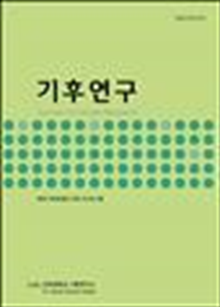간행물
기후연구 KCI 등재 Journal of Climate Research

- 발행기관 건국대학교 기후연구소
- 자료유형 학술지
- 간기 계간
- ISSN 1975-6151 (Print)2288-8772 (Online)
- 수록기간 2006 ~ 2021
- 주제분류 사회과학 > 지리학 사회과학 분류의 다른 간행물
- 십진분류KDC 453DDC 551
권호리스트/논문검색
제11권 제3호 (2016년 9월) 5건
1.
2016.09
서비스 종료(열람 제한)
High temporal resolution precipitation data can provide information about rainfall intensity, and can better reveal the essential physical process of precipitation intensity than daily totals do. Using hourly precipitation data at 14 stations during 1961-2014, the changes in the characteristics of summer precipitation in South Korea analysed. Although the precipitation amount in summer has increased at all stations, hourly precipitation in summer shows different directions and magnitudes of changes at each station in South Korea. Results showed that the change pattern of hourly precipitation is mostly attributed to change in the frequency of hourly precipitation of 10mm or more.
2.
2016.09
서비스 종료(열람 제한)
This paper used the Bayesian model averaging (BMA) with gamma distribution that takes the form of probability density functions to calibrate probabilistic forecasts of wind speed. We considered the alternative implementation of BMA, which was BMA gamma exchangeable model. This method was applied for forecasting of wind speed over Pyeongchang area using 51 members of the Ensemble Prediction System for Global (EPSG). The performances were evaluated by rank histogram, means absolute error, root mean square error, continuous ranked probability score and skill score. The results showed that BMA gamma exchangeable models performed better in forecasting wind speed, compared to the raw ensemble and ensemble mean.
3.
2016.09
서비스 종료(열람 제한)
We examined temporal and spatial structure of trends in precipitation-based and temperaturebased extreme indices simulated by the Regional Model Program of Global/Regional Integrated Model System (GRIMs-RMP). The extreme indices were selected to consider the frequency, intensity, and persistence of extreme events. During the Last 30 years from 1979 to 2008, the model reasonably have simulated the temporal and spatial pattern of the trend. Although overestimation of minimum temperature and underestimation of maximum temperature occured, the regional climate model captured observed direction and magnitude well in the indices based on temperature. The indices related to rainfall tended to be overestimated over East Asia except for Korea and Japan. However, the trend showd agreement with observation.
the results allow us to be optimistic about the RCM ability in the simulation of important extreme event of precipitation and surface temperature in East Asia. This type of study can also provide meaningful climate statistics and insight into climate change impact study.
4.
2016.09
서비스 종료(열람 제한)
Aerosols play the important role as scatter or absorb solar radiation, which consequently modi es the radiative balance of the atmosphere. Aerosol and its e
ects, especially its indirect e
ects, on climate have drawn increasing attention in recent years. Understanding of interactions of aerosols and climate is important to better prediction of future climate change. In this study, the direct and indirect effect of fossil fuel organic carbon aerosol (OC) and its impacts on the climate during the period of the early of 20th century (1901~1920) and the end of 20th century (1986~2005) were investigated. we examine changes in aerosol emission during 20th century. Using HadGEM2-AO (Hadley Centre Global Environmental Model version 2, Atmosphere and Ocean), historical experiments are carried out with and without anthropogenic aerosol emissions (HIST, FIXA) from 1860 to 2005. Fossil fuel organic carbon aerosol (OCFF) emission xed at 1860 is added. Due to the large emission of OC, thick optical depth of the OC appears over Asia, western Europe and eastern north America.
e direct eect due to increasing OC influences negative radiative effect at the surface, which leads to a cooling effect on the surface. The OC shows direct eect and indirect eect as well.
e variation of total amount of clouds are aected by the OC aerosols emission.
5.
2016.09
서비스 종료(열람 제한)
This paper applied the ensemble model output statistics (EMOS) with truncated normal distribution, which are easy to implement postprocessing techniques, to calibrate probabilistic forecasts of wind speed that take the form of probability density functions. We also considered the alternative implementations of EMOS, which were EMOS exchangeable model and reduced EMOS model. These techniques were applied to the forecasts of wind speed over Pyeongchang area using 51 members of the Ensemble Prediction System for Global (EPSG). The performances were evaluated by rank histogram, mean absolute error, root mean square error and continuous ranked probability score. The results showed that EMOS models with truncated normal distribution performed better than the raw ensemble and ensemble mean. Especially, the reduced EMOS model exhibited better prediction skill than EMOS exchangeable model in most stations of study area.

